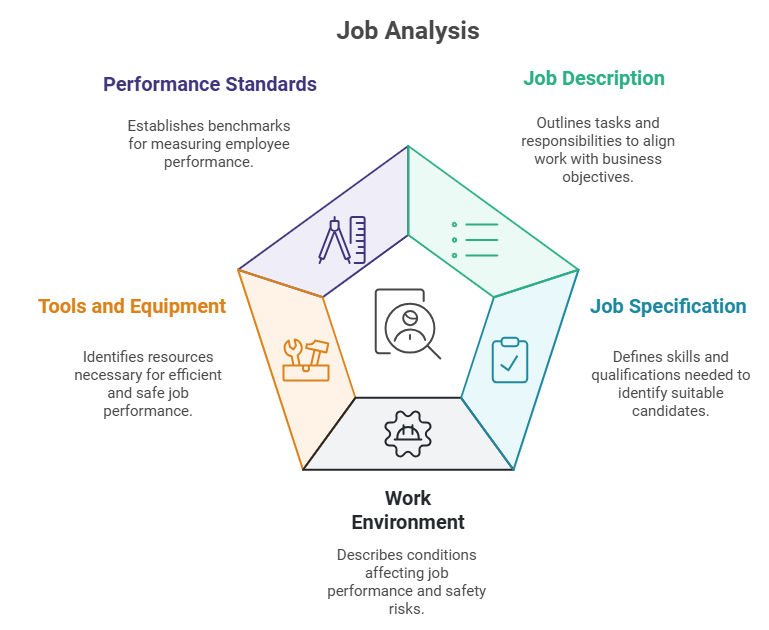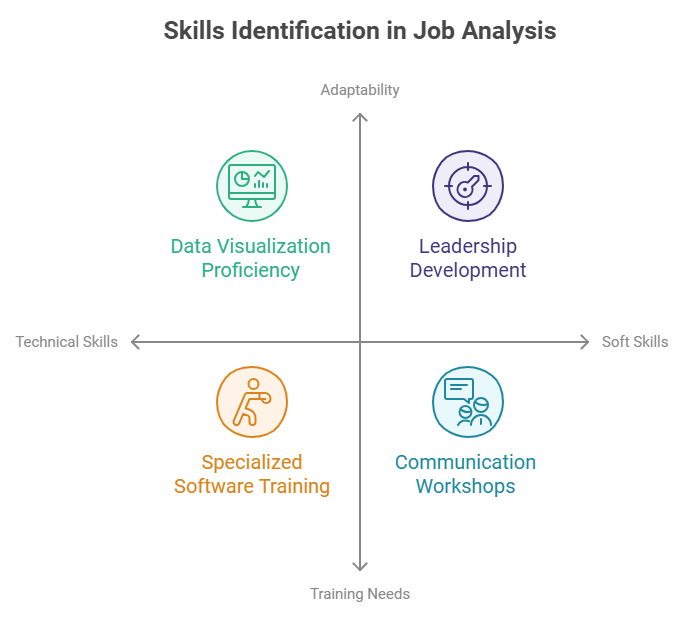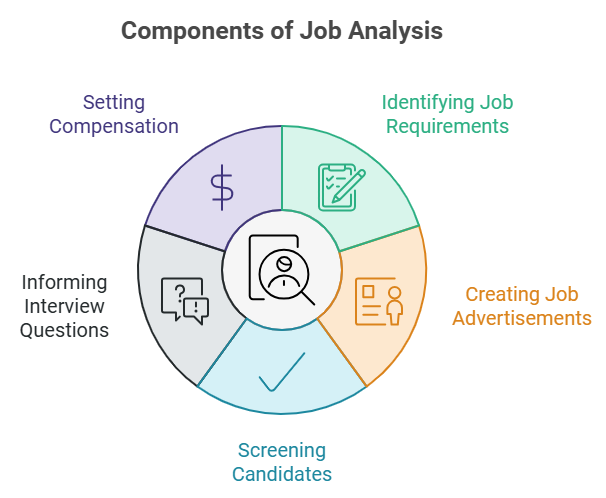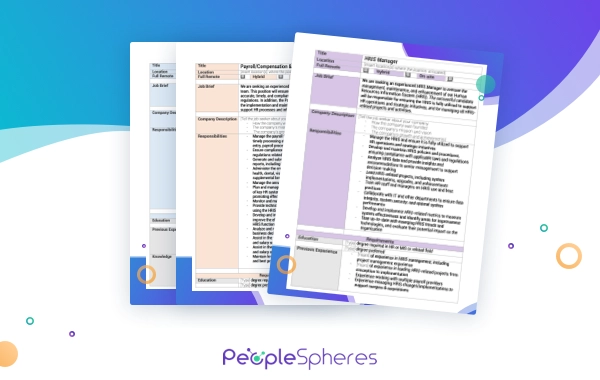
Delving into the realm of human resources, we find numerous concepts and strategies that underpin successful business operations. One such concept is job analysis, a comprehensive process that involves examining and evaluating the various components of a job. Job analyses play a critical role in various facets of organizational functioning, including recruitment, performance appraisal, and training.
In the realm of recruitment, job analysis helps in identifying the key skills, qualifications, and competencies required for a specific job role. By conducting a detailed analysis of the job, organizations can create accurate job descriptions and job specifications, which are crucial for attracting and selecting the right candidates.
Related articles:
What are the Best Employee Engagement Strategies?
Create a Compensation Plan in 7 Steps
What is Job Analysis?
A job analysis is a systematic procedure for identifying, recording, and analyzing a job’s requirements and the necessary skills to perform it.
This process involves a detailed study of the job duties, responsibilities, tools and equipment used, work environment, and the attributes needed to perform the job effectively. This critical information aids HR professionals in developing job descriptions, setting standards for employee performance evaluation, and integrating an employee’s job duties with their goals and abilities.
Frequently Asked Questions
What are the key components of a job analysis?
- Job Description: This is a written statement outlining the general tasks, duties, and responsibilities of a particular role. It acts as a guide for employees to understand what is expected of them in their roles, helping to align individual work with overall business objectives.
- Job Specification: Job specification outlines the skills, qualifications, experience, and personal attributes necessary for performing the job effectively. It helps recruiters to identify suitable candidates for the job during the recruitment process.
- Work Environment: This involves detailing the physical, emotional, and social conditions in which the job is performed. Understanding the work environment can help in evaluating any potential health or safety risks associated with the job, and implementing appropriate measures to manage them.
- Tools and Equipment: This refers to the physical resources required to perform the job, including any machinery, software, or other tools. Identifying these requirements can help in ensuring that employees have the necessary equipment to perform their duties efficiently and safely.
- Performance Standards: These are the benchmarks against which an employee’s performance in a particular role is measured. Clearly defined performance standards can help in setting expectations for employee performance and guiding performance evaluations.

How does a job analysis contribute to the recruitment process?
Job analyses significantly contribute to the recruitment process in several ways. First, by defining clear job descriptions and specifications, it sets a solid foundation for recruitment, providing a clear understanding of what the job entails and the kind of candidate needed. This helps recruiters to tailor their search and selection criteria, increasing the chances of finding a perfect match for the role.
Second, understanding the work environment and tools needed for the job allows recruiters to set clear expectations with potential candidates, reducing the chances of job dissatisfaction and turnover.
Lastly, performance standards defined during job analysis can be used in the recruitment process to communicate the expectations of the role to potential candidates. This ensures that candidates have a full understanding of what is expected of them, fostering a smoother onboarding process and setting the stage for future performance evaluations.
What specific skills can it help identify?
- Technical Skills: By studying the tasks and duties of a job, analysts can determine the specific technical skills required. For example, a job that involves data analysis may require proficiency in data visualization tools.
- Soft Skills: Job analysis can also shed light on the interpersonal or “soft” skills a role might require. For instance, a manager’s role may require strong leadership and communication skills.
- Training Needs: If a role requires specialized knowledge or skills, job analysis can help identify the need for specific training or professional development courses.
- Adaptability: In today’s rapidly changing work environment, adaptability is a highly valued skill. By analyzing a job’s requirements and work environment, one can assess how much adaptability is required for the role.

How does a job analysis differ from a job description?
A job analysis and a job description, while interrelated, serve distinct purposes.
A job analysis is a comprehensive process that examines the assorted elements of a job, including the tasks, tools, skills, and context of the job, in order to understand it thoroughly. It’s a deep dive into the complexity of a particular role that helps to identify the necessary skills, experience, and responsibilities attached to that position.
On the other hand, a job description is a direct product of the job analysis. It is a document that outlines the key findings from the job analysis in a concise, easy-to-understand manner, and serves as a reference for both hiring managers and potential candidates. The job description typically includes the role’s key duties, necessary qualifications, working conditions, and sometimes, details about the compensation and benefits.
What tools and techniques are commonly used in the analysis?
- Identifying Job Requirements: Job analysis helps pinpoint the skills, qualifications, and experience needed for a job, enabling recruiters to target their search more effectively.
- Creating Job Advertisements: The information gathered from a job analysis can be used to craft detailed and accurate job advertisements, ensuring that potential candidates have a clear understanding of the role.
- Screening Candidates: Job analysis helps in establishing the criteria for screening applicants, allowing recruiters to effectively and fairly evaluate candidates based on their suitability for the role.
- Informing Interview Questions: The detailed understanding of a position afforded by job analysis can aid in the creation of relevant interview questions, facilitating a comprehensive evaluation of a candidate’s capabilities.
- Setting Compensation: With a comprehensive understanding of the job’s responsibilities and required skills, job analysis can assist in setting an appropriate compensation level.

What role does job analysis play in performance appraisals and training?
For performance appraisals, it provides a well-defined set of criteria against which an employee’s job performance can be evaluated. It sets clear standards and expectations, enabling managers to assess if employees are meeting their job requirements, thereby impacting their performance ratings.
As far as training is concerned, job analysis aids in identifying the skills and knowledge required for a job and highlights areas where training might be needed. It can reveal gaps in an employee’s abilities in relation to their job requirements, facilitating the development of targeted training programs to bridge these gaps. This ensures that employees are equipped with the necessary skills to perform their roles effectively.
How often should a job analysis be conducted?
A job analysis should be conducted periodically, ideally every two to three years. However, it may be necessary to conduct a job analysis more frequently in certain situations, such as when there are substantial changes to a job’s duties or requirements, following a restructure of the organization, or when new technology or techniques are introduced that significantly impact the way a job is performed.
Regularly updating job analyses ensures that they accurately reflect the current demands and realities of each position within an organization.
How can job analysis contribute to employee retention strategies?
Job analyses play a vital role in employee retention strategies. It provides a detailed understanding of the roles, responsibilities, and skills required for a job, offering a foundation for developing effective recruitment, training, and development programs. By ensuring that employees are well-matched to their roles and have opportunities for growth and development, job analysis can enhance job satisfaction and loyalty.
Moreover, through its role in performance management, job analysis can help ensure that employees receive fair and accurate evaluations, feedback, and recognition, which can further promote retention. Regularly revisiting and updating job analysis can also help organizations adapt to changes and ensure employees’ skills and roles align with evolving organizational needs, contributing to long-term employee engagement and retention.
What challenges might an organization face when conducting job analyses?
Conducting a job analysis can present several challenges for organizations. Firstly, the process can be time-consuming and resource-intensive, particularly for larger organizations with numerous and varied roles.
Secondly, accurately capturing the nuances and complexities of certain job roles can be difficult, especially for roles that involve intangible or creative tasks.
Thirdly, job roles and requirements may change rapidly in dynamic industries, making it challenging to keep job analyses up-to-date.
Lastly, involvement of subjective biases in the analysis process can lead to inaccuracies. To mitigate these challenges, organizations need to plan carefully, involve various perspectives including those of incumbents and supervisors, and ensure regular updates to job analyses.

-360x360.jpg)


